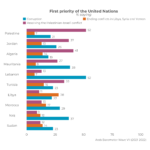Over the last eight years, contentious actions such as street protests and sit-ins have been a constant presence in news reports from the MENA region. While a significant number of academic, journalistic, and think-tank articles have focused on the causes of social discontent and contentious actions in the region since 2011, few works have used a quantitative approach to investigate the determinants of protest participation. This paper contributes to this literature by offering a comparative analysis of protest participation in 2011 and 2018–2019 in four Arab countries (Egypt, Tunisia, Jordan, and Algeria), using the data provided by the second and fifth wave of the Arab Barometer. It finds a persistent and increasing level of protest participation throughout the two waves, even in countries such as Egypt, where repressive policies have worsened over the last years. Moreover, gender, education level, income, and level of religiosity emerge as the most consistent determinants of participation in both waves. Overall, being male, having higher education, being from the upper half of the income distribution, and being non-religious are the characteristics significantly linked to protest participation in most cases. However, considerable differences persist from country to country.The picture emerging from the analysis shows a persistent and increasing level of contention, which can be interpreted as the sign of an ongoing process of social and political change throughout the region.
Read full article at ISPITopics
- Charity2
- Corruption113
- COVID-1969
- Democracy35
- Discrimination13
- Economy226
- Education51
- Environment36
- Extremism19
- Freedoms50
- Gender Issues159
- Governance253
- Health44
- International Relations193
- Labor Market35
- Media31
- Migration63
- Political Institutions213
- Political Participation33
- Political Systems60
- Refugees6
- Religion118
- Security31
- Social Justice44
- Wellbeing2
- Youth75


